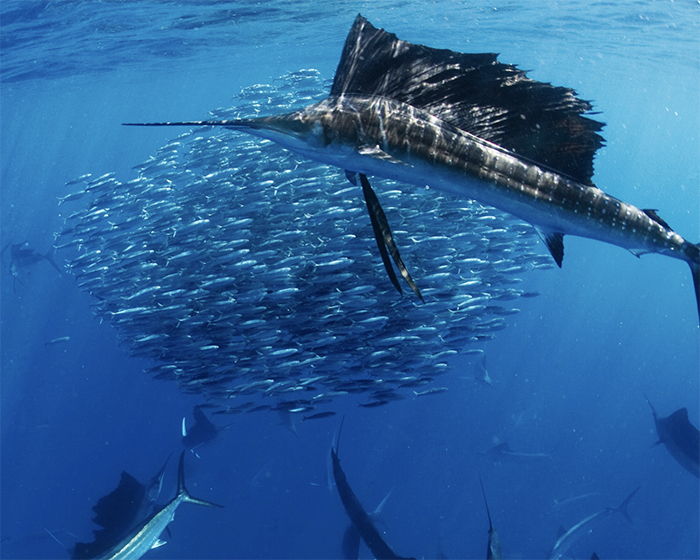
Peter Zeihan: Europe Goes Nuclear
We’ve got two major developments in Eurasia. We’re talking about Ukraine disabling two ships in the Caspian Sea and Poland getting EU approval to build…
Thought Leader: Peter Zeihan

Recommended: See source for photos.
You don’t know speed until you have swum among sailfish.
These large ocean predators live and feed in the waters of the Mexican Caribbean, where I traveled to find them some 20 to 60 miles off the north-northwestern shore of Isla Mujeres, in the Yucatan Peninsula.
Sailfish have a giant dorsal fin, or sail, and a powerful bill — both crucial parts of their hunting gear. They can also display an amazing array of colors, which can change as their environment and activities change. The brightest colors flash when the fish are stressed or excited.
Every day I would go out with my boat captain, a very experienced sports fisherman, and spend all day at sea looking for sailfish. We were working in rough water, so finding ‘bait balls’ of smaller fish, where sailfish might be hunting, was not easy. Bait fish, like sardines and anchovies, form tightly packed balls of fish that are swimming in synchronicity. In our attempts to find them, we would spend hours looking for birds hovering over the ocean. When you find birds out at sea, you can tell based on the way they are tracking whether or not they are following a bait ball.
Underneath a bait ball of fish like anchovies or sardines, you can often find sailfish and other predators. These very fast predators use their prey’s behavioral instincts to drive them up from deeper water, packing the ball tighter so they can hunt more easily near the sunlit surface.
Watching sailfish hunting is fascinating, as the smaller fish that are being corralled in the bait ball — sometimes several thousand strong — will move and behave almost like an individual organism.
Every time I got into the water I was able to see the bait ball at a different stage of formation, but one day I witnessed the whole hunting scene. Jumping into the water that day, I saw 40 to 60 sailfish surrounding a very large bait ball. These bait balls have a lot of power and speed when they move together, and it looked as though the sailfish were having a hard time controlling it. Then all of a sudden I saw several put their sails down, and cut into the ball with their bony bills to isolate a smaller cluster from the main group—more controllable as the fish zigzag to elude capture.
It was extraordinary to watch these sailfish cooperate, as they worked together to turn the unwieldy bait ball into a more manageable cluster. One by one sailfish would come in close to the bait ball, sails down, and then all of a sudden the sail would pop up — you could actually hear it, like the swoosh of an opening fan. Flashing wild colors, iridescent blues and oranges, the sailfish would try constantly to confuse the bait ball.
Once a smaller ball was under control, the sailfish would take turns shooting towards it. Thrusting their bills deep inside the bait ball, they made a cutting, side-to-side motion. I could even hear it underwater, like a shtt, shtt, shtt sound as if they were slicing the sardines. They were able to use their bills to strike individual fish with remarkable precision, and pursuers would then nab stunned fish before they could escape.
Sometimes the sailfish would decapitate the sardines or cut them down, but usually, they would just wound them, wearing them down for as long as two or three hours. They would just keep controlling the bait ball, not letting it dive, and all the time weakening it further. Battered prey might attempt to flee, but few escaped the sailfish that chased them down.
Eventually, the ball would start to get really tired, and they would move in a slow vortex, on their own axis, at the surface. No longer in perfect concert and whittled down to the last stragglers, at this point, it was like they had finally given up. Then the sailfish would come and attack in a massive frenzy. Before I knew it, the ball would be gone.
To me, these fish were behaving more like mammals than fish. They hunted in unison, and their behavior resembled an orca hunt — intelligent and calculated. It was one of the greatest surprises that I have ever had in the ocean, and it was a real privilege to be there to witness it.
Peter Zeihan: Europe Goes Nuclear
We’ve got two major developments in Eurasia. We’re talking about Ukraine disabling two ships in the Caspian Sea and Poland getting EU approval to build…
Thought Leader: Peter Zeihan
Dr. Sanjay Gupta’s Top Health Stories of 2025
From the resurgence of measles to a new way to treat pain, 2025 was a challenge for public health while still offering moments of hope. Sanjay…
Thought Leader: Sanjay Gupta
Ian Bremmer: The state of global conflict in 2025
On GZERO World, Ian Bremmer takes a hard look at the biggest global crises and conflicts that defined our world in 2025 with CNN’s Clarissa…
Thought Leader: Ian Bremmer

